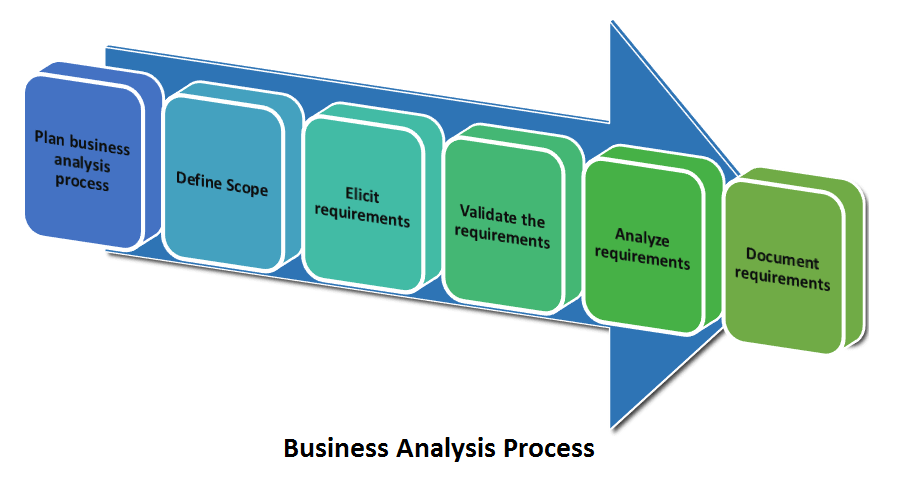Business analysis is a multistage process aimed at identifying and defining the requirements that must be fulfilled to achieve ‘business objectives’. Business analysis is carried out in every project irrespective of the industry to the project belongs, project size, project complexity or project type.
Performing business analysis is the core responsibility of a business analyst and he does this by liaising with different stakeholders involved in the project.
The process of business analysis starts after the business requirements are documented and the BRD (Business Requirements Document) is available. Described below are the steps that must be followed to conduct business analysis.
1. Plan Business Analysis Process
Activities are better managed if you plan how to achieve them and thus the ‘Business Analysis plan’ contains the steps that will be followed to conduct the process of business analysis. The plan encompasses:
- Requirement management plan.
- The listing of the stakeholders from which the requirements will be elicited.
- The techniques which will be used to extract requirements.
- The templates of different documents that will be created in the course of requirement gathering.
- Details of shared locations where the documents will be stored.
- Documents validation and review process.
- Mode of communications (including frequency) of the business analyst with the other stakeholders.
- Tracking and versioning details for the documents.
The above things, if properly planned, documented and followed will extensively contribute to the overall success of the project.
2. Define Scope
Project scope defines what all is expected to be achieved by the project so as to be considered complete and successful. It includes:
- Description of the Project scope.
- What is within the scope and what is out of the scope
- Deliverables to be accomplished.
- The acceptance criteria of the deliverables
- Any constraints against the project.
- Assumptions taken for the project.
A business analyst works closely with the project manager and the key stakeholders of the project to define the project scope statement and the project scope. All the requirements that are included in the project scope should be carefully validated against the project’s business requirement document (BRD)/business case.
3. Elicit Requirements
Once the project scope statement is defined we must strive to get as much information as possible regarding all the requirements of the project. Elicitation is the part of business analysis where a business analyst communicates and liaise with all the stakeholders, understand their needs and document the requirements of the solution that needs to be developed.
We have already seen the various techniques used by a business analyst to draw requirements and the associated tools. As a refresher, a business analyst will conduct interviews, workshops, observation, questionnaire and prepare prototypes to get requirements out of the stakeholders.
Elicitation is not an easy exercise since one needs to get in touch with all the stakeholders involved, understand their needs and spend a considerable amount of time trying to comprehend the demands. This is an important phase of the project where the business analyst should be careful not to miss any requirement or stakeholder.
4. Validate the Requirements
Once the requirements are captured they must be validated against the business requirements/business case of the project. Some stakeholders might demand features that are out of the project scope and the business analyst should highlight any such requirements. These requirements should be brought to note of the other stakeholders and discussed whether they should be discarded or could be part of future phases of the project.
Additionally, there might be some technical constraints that will hinder the achievement of a requirement. In such cases, the business analyst should closely work with the technical architects, technical leads and come up with workarounds. These workarounds should then be discussed and agreed upon with the client/other stakeholders.
5. Analyze Requirements
Till now we have discussed how to gather data about ‘what’ the solution is expected to achieve but it is equally important to define ‘how’ these requirements will be achieved. The elaboration of this ‘how’ is a part of the analyze requirements process. Let’s go through the things that are the part of this process:
- Prioritize the requirements for their validity and any associated risks (technical, infrastructural or schedule)
- Deduce inter-dependencies between requirements
- Create a data model
- Crate the domain model
- Create the process flow diagram
- Create a process interface model
- Deduce any technical or business constraints and related assumptions.
- Validate the correctness of the requirements.
Since the ‘Analyze requirements’ process is a crux of the activities a business analyst does, we have created a dedicated article for it here.
6. Document Requirements
Once the requirements are properly elicited and analyzed, it’s time for them to get documented. Documenting requirements is a tricky exercise where both technical knowledge and writing skills are equally important. Since there are many audiences of the documents prepared by the business analyst belonging to different competencies in an organization (technical, business, etc.), excessive care should be taken while documenting requirements. A business analyst should note that:
- Requirements should be crisp, clear and concise.
- Requirements should be written in a simple language.
- In case of usage of technical terms, they should be defined in the glossary.
- The documents should be versioned for ease of identification.
- Documents should be reviewed for their correctness and exactness.
- The document templates and nomenclature should be followed according to the Business Analysis plan/requirement management plan.
- Requirement documents should be validated and approved by the key stakeholders.
Also, the different documents in which the requirements are stored are as follows:
- Use case diagram
- System requirements specification (SRS) document.
- Activity diagrams
To sum up, the complete process of Business Analysis is centered around planning the analysis process, defining the scope, getting detailed requirements, validating their value against the project business case, analyzing how to achieve these requirements and lastly documenting them.

